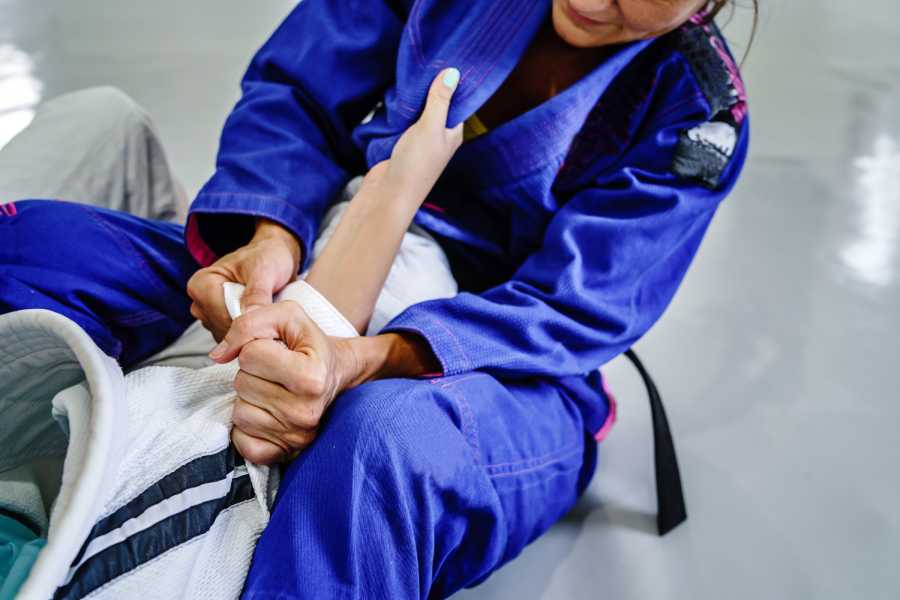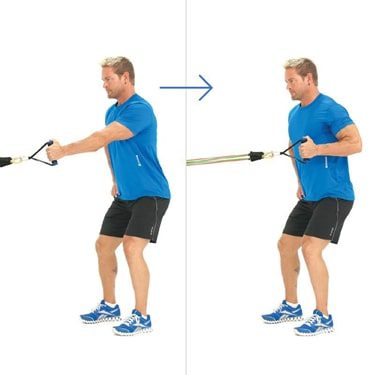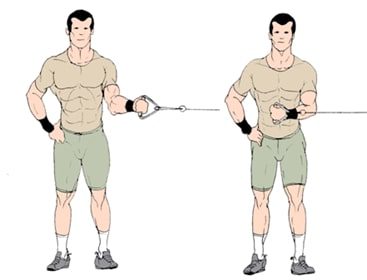Have you ever questioned how hard escaping any armlock would be if you couldn’t rotate your arms without pain?
Training BJJ with a rotator cuff injury is not a great idea. You might be able to power through the pain, but you might make things even worse for yourself in the long run.
The rotator cuff is essential for our arm movement. We use it to push, pull, lift, and pretty much every weird move we make when we are in the heat of a rolling session.
Let’s dive into the BJJ rotator cuff injury and how it affects the muscle and its performance in training and life.
Table of Contents
- BJJ Rotator Cuff Injury Briefly Explained
- Should You Train Through BJJ Rotator Cuff Injury?
- How To Still Train BJJ With My Shoulder Injury?
- BJJ Rotator Cuff Injury Exercises
- What Is The Recovery Time After A Rotator Cuff Injury?
- If You Can’t Train BJJ With Rotator Cuff Injury, What Are Your Other Options?
- Can Jiu-Jitsu Training Cause Or Aggravate A Rotator Cuff Injury?
- Treatment Options For A Jiu-Jitsu Rotator Cuff Injury
- Prevention Tips For Avoiding A Rotator Cuff Injury As A Jiu-Jitsu Practitioner
- Train BJJ With A Rotator Cuff Injury – Final Word
BJJ Rotator Cuff Injury Briefly Explained

The Rotator cuff is the group of muscles and tendons in the shoulder that keep the ball of the humerus bone in the shoulder blade socket. They allow us to lift and move our arms away from the body.
A rotator cuff tear can occur when the tendons pull away from the arm bone. It might be due to overuse or a preexisting injury.
There are two types of tears that we have to worry about when training BJJ:
- Partial Tears – The tendon is still somewhat attached to the arm bone.
- Complete Tear – The tendon completely separates from the bone, leaving a hole or rip in the tendon.
When your rotator cuff injury is partial, then there is a good chance you might need a shoulder brace to avoid aggravating your BJJ shoulder injury.
Should You Train Through BJJ Rotator Cuff Injury?

The rotator cuff tears usually occur over time. This happens as the tendon grows old and wears down from use, as a degenerative tear.
Most people over 40 years old are at risk of rotator cuff tears.
A degenerative tear might happen due to multiple factors, including:
- Bone Spurs.
- Decreased Blood flow.
- Overuse.
A sudden tear from an accident causes immediate and intense shoulder pain and arm weakness.
is 50 too old to learn BJJ?
Degenerative BJJ Rotator Cuff Tears
There could be mild pain that improves with painkillers when it comes to degenerative tears. But, it is only a matter of time before the pain becomes worse and they become useless.
Some signs of a rotator cuff tear are:
- Raising your arm with pain or difficulty.
- Hearing pops or clicking, along with weird sensations when the arm moves.
- Pain that grows when resting the arm.
- Struggle when lifting the arm and shoulder weakness in general.
For anyone who practices BJJ, just reading the signs of a rotator cuff tear should be enough to make you worry about being able to train.
An injury of this kind will get worse if there is no treatment.
A complete cuff tear can make it almost impossible to move the arm, and without any treatment, it could cause chronic shoulder pain or make it very difficult to use the arm.
Training with a partial tear could be possible, and we will look into that, but a complete tear is something that you shouldn’t mess with.
How To Still Train BJJ With My Shoulder Injury?
You might be wondering, can I do Jiu-Jitsu with a bad shoulder? If you injure your rotator cuff, you will feel pain and experience an inability to lift the arm properly.
This will seriously limit your options in BJJ rolling, making sleeping on one side of the body complicated and uncomfortable.
You can always power through the pain and still practice, but training BJJ with a shoulder injury is not the brightest idea. Above all, prioritize your long-term health over short-term BJJ training gratification.
It will always be better to take the proper time to rest when it comes to a BJJ rotator cuff tear.
don’t miss the Best bjj gis
BJJ Rotator Cuff Injury Exercises
Here is a list of a few examples of exercises that you can do to strengthen your shoulder muscles to prevent a rotator cuff tear.
You can also perform these exercises if you have a partial tear and go through them as physical therapy.
However, consult your doctor and physical therapist before trying any of these exercises.
We added a simple explanation of the method in which the exercises are done, along with an image to make it easier to understand:
Standing Row

- To do this simple exercise, all you have to do is tie a stretchy workout band to a sturdy object.
- Hold the end of the band with your hand and stand far enough to have no slack.
- Keep the arm close and bent at the elbow, with a 90-degree angle.
- Pull the elbow back and stretch.
Workout bands are inexpensive and can do wonderful things for your recovery. I recommend you get the resistance bands with a handle. Furthermore, you can get a set with different levels of resistance. You can progressively increase the resistance progressively to make your shoulders stronger again.
grab a resistance band set here
Internal Rotation

This exercise is similar to the standing row and starts the same way.
- Using a stretching band attached to an object and bending the elbow.
- After you turn the elbow, cross the forearm across your midsection.
- Pull back to the side.
Crossover Arm Stretch

This stretch starts in a neutral position.
- Keep relaxed shoulders, and then stretch the affected arm across your chest.
- Hold that arm at the elbow with the help of your other arm, and keep the position until you start feeling some strain in the muscles.
Posterior Stretch

The posterior stretch is similar to the crossover stretch but is less intensive.
Everything starts the same, but you let your armrest on the opposite shoulder once you reach across the body.
What Is The Recovery Time After A Rotator Cuff Injury?
A BJJ rotator cuff tear is unable to heal on its own without surgery.
Some patients can improve functionally and have decreased pain by strengthening their shoulder muscles without requiring any surgical treatment.
However, eight out of every ten people with partial tears can improve their condition with nonsurgical treatments. It can take up to a year for their situation to improve.
But what options do you have available to stay in shape if BJJ becomes too much of a risk?
If You Can’t Train BJJ With Rotator Cuff Injury, What Are Your Other Options?
If the pain from the torn rotator cuff doesn’t allow you to train BJJ, you have a few options to hit if you want to work out.
Most of these options are the focused exercises that we previously pointed out, as you should avoid any weight lifting altogether.
If you go ahead and lift objects over your head or out from the sides, it will likely cause more stress and even aggravate the injury.
Another thing to avoid would be overhand motions like those done when swimming. If the pain allows it, your best option to stay active besides physical therapy might be going for a walk every day.
Can Jiu-Jitsu Training Cause Or Aggravate A Rotator Cuff Injury?
Brazilian Jiu-Jitsu can help strengthen shoulder muscles to reduce the chance of a rotator cuff injury, but it could also generate overuse and cause it.
Sadly, when it comes to the rotator cuff injury itself, we have to say that Jiu-Jitsu most likely will aggravate it unless you take proper rest and care of the damage.
It’d be in your best interest to take enough time to heal or check if surgery is the most viable option for a speedy recovery.
Treatment Options For A Jiu-Jitsu Rotator Cuff Injury
Some of the non-surgical treatment options include:
- Rest.
- Nonsteroidal anti-inflammatory medicines.
- Strengthening and stretching exercises.
- Ultrasound therapy.
- Corticosteroid injection.
If there is a complete cuff tear, you will require surgery, but that could also be an option if nonsurgical treatments do not help in the case of a partial tear.
Surgery is also an option if your job or athletic goals seem affected by the shoulder injury. Most rotator cuff surgeries are outpatient procedures, and you can go home the same day.
The overall recovery is substantial and could take a year or even more to heal. After the procedure, you might need to wear a sling to immobilize the arm for a little over a month.
After that time, physical therapy can begin, and shoulder function should recover within four to six months.
Full strength and motion may take up to twelve or even eighteen months. During that time some therapists might recommend a shoulder brace. Try to not to use it all the time. The brace could hinder your recovery by making your muscles weaker.
Use the brace only when you need some rest after days of intense pain and therapy.
But what are some other things you can do and why a shoulder brace would help?
Shoulder Brace – BJJ Rotator Cuff Injury Treatment
If your rotator cuff injury is partial, then there are many steps that you should take in order to avoid worsening your injured shoulder. A few of those steps are:
- Wearing a shoulder brace
- Do not sleep on it when possible
- Make sure that you have good posture and a stable arm wave while doing daily activities.
A shoulder brace will be very useful in avoiding further damage to your rotator cuff injury. Your shoulder brace will have a strap that goes over your shoulder and a strap that goes around the back of your torso.
You should wear your shoulder brace when sleeping and doing daily activities (if the pain is strong), to avoid further injury to your rotator cuff injury.
The shoulder brace works because of a few reasons: one is helping to keep the bones in your shoulder in place. This can prevent further injury to your rotator cuff injury or possibly even improve the way that your rotator cuff pain is felt.
The other reason that a shoulder brace will help with your rotator cuff injury is due to the brace is able to reduce the amount of stress put on your arm when lifting and exercising. But remember, ask your doctor before committing to the shoulder brace.
Prevention Tips For Avoiding A Rotator Cuff Injury As A Jiu-Jitsu Practitioner
To prevent a BJJ rotator cuff tear, you’ll need to keep the muscles and tendons flexible and continue to strengthen them:
Daily Shoulder Strengthening exercises
People usually exercise the front muscles of the chest, shoulders, and upper arms.
Another important, often overlooked exercise is strengthening both the muscles in the back of the shoulder. Especially those in the shoulder blade to optimize shoulder muscle balance.
There is an endless library of rotator cuff exercises for those actively looking for exercises that you could look up when you search on Youtube.
Three excellent Rotator Cuff Pain Exercises
As you grow older, these exercises should become part of your daily routine as degenerative tear becomes a possibility.
Thankfully, it shouldn’t take too much time, and the exercises are simple enough.
Train BJJ With A Rotator Cuff Injury – Final Word
A shoulder injury is not a joke, especially in Brazilian Jiu-Jitsu, where some high percentage submissions like the Americanas and Kimuras directly attack the rotator cuff.
If you happen to tear your rotator cuff, take the time to rest and properly heal, as it is not an injury you can just power through without some serious repercussions.
If you enjoyed the content of this article and have a friend or BJJ classmate who has developed a partial or complete tear, share the link so he can take the time to read it.
If you have something to share, don’t forget to leave us a comment.






